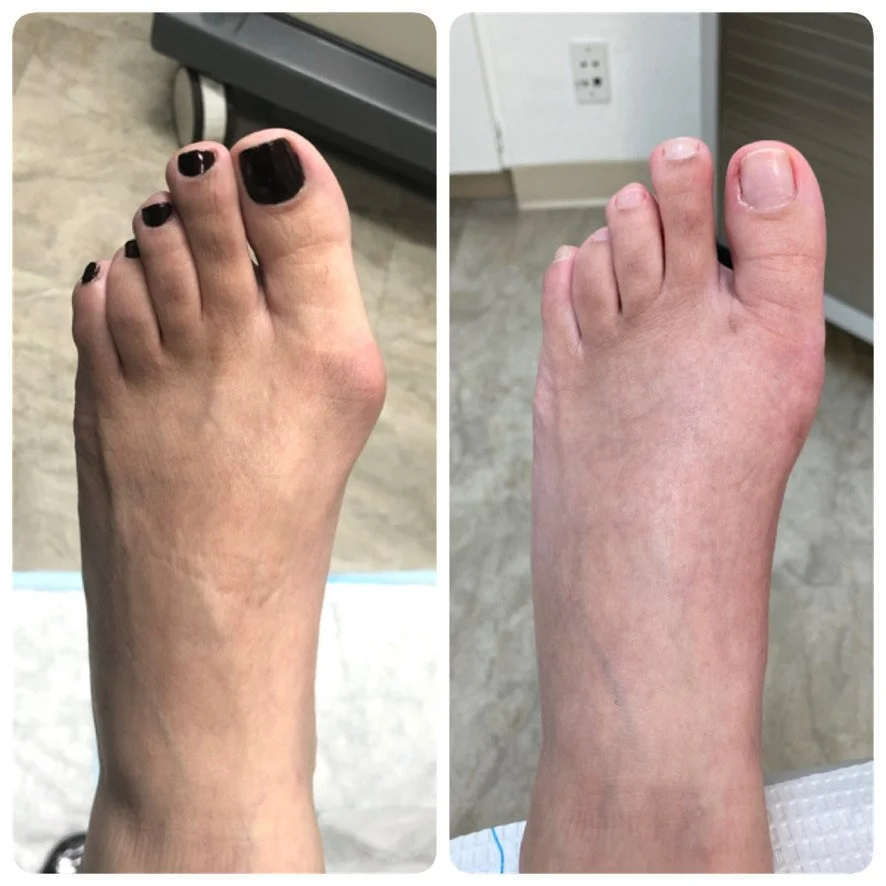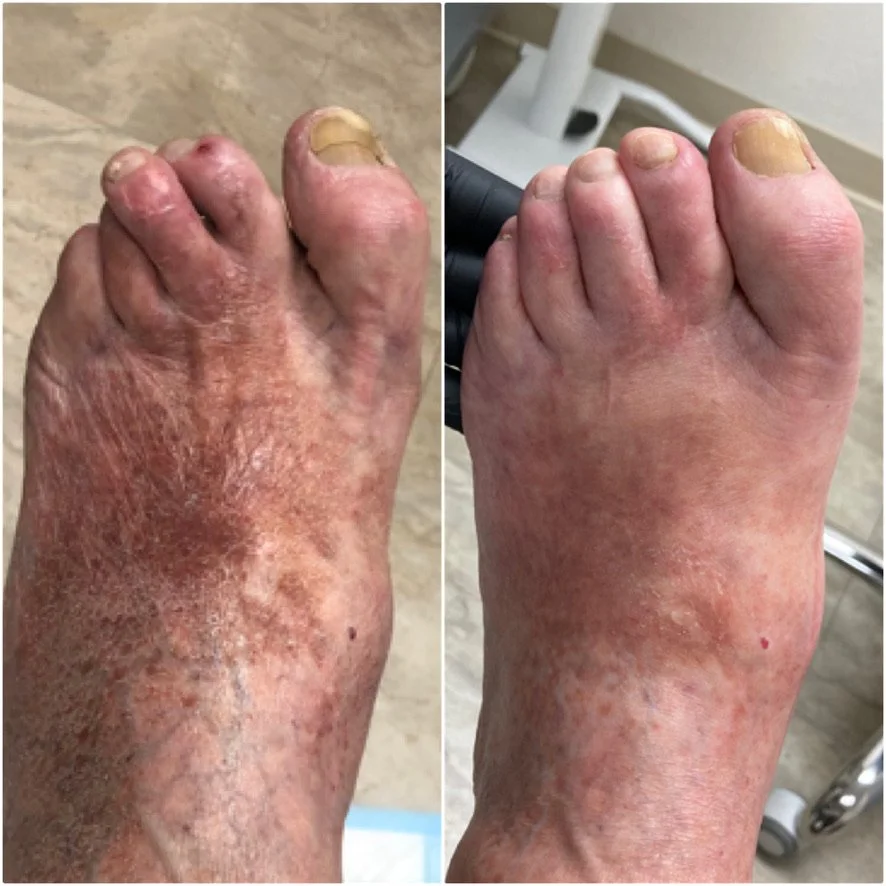
Minimally Invasive Foot Surgery
Restore function with cosmetic results through Minimally Invasive Surgery (MIS)
Got crooked toes that hurt?
Toe deformity is more than a cosmetic problem. Any imbalance with the toes can lead to pain, difficulty wearing shoes, chronic nail deformity, calluses, corns, open sores, and balance issues. Not to mention the social embarrassment that can affect your confidence and well-being causing you to miss out on life.
Many types of toe deformities benefit from minimally invasive surgery (MIS), including:
Bunions
Bunionette (Tailor’s bunion)
Hammertoe
Mallet or claw toe
Toes that cross over or turn sideways
Long toe
Short toe
Complex revisions

What you need to know about toe surgery

Traditional toe surgery can leave large scars
Gone are the days of surgery with large incisions, using pins, screws, or other implants that increase the risk of persistent swelling, infection, excessive trauma, and implant rejection.
With minimally invasive surgery, you can expect
an invisible scar
less pain, less narcotics
less swelling
shorter recovery time
and straighter toes!
Many patients are back on their feet shortly after minimally invasive surgery.
If conservative options are not giving you relief, surgery may be the solution for trouble-free toes. Here’s how we’re different from traditional options:
Traditional
Surgery
Long incisions
Unsightly scar
Requires general anesthesia
Internal hardware (screws & pins) that will need removal later
Correction may be too rigid or unnatural looking
More trauma means longer downtime & more pain
Minimally Invasive Surgery
No sutures are needed with poke hole incisions
Invisible scar
Local anesthesia (awake surgery)
No hardware or metal reaction/rejection
No need for secondary surgery for hardware removal
Walk right after surgery
Less trauma means less pain & swelling

You don’t have to walk with pain or deformity
No one should have to experience pain with walking or be limited in their shoe choices because they’re embarrassed about their toes.
If conservative options are not giving you the results you’re looking for, consider minimally invasive surgery with Dr. Tea, a board-certified fellowship-trained foot and ankle specialist who has proven her commitment to giving her patients functional feet with cosmetic results.
You can’t afford to have foot pain.
Pain from toe deformities do not get better with time, they actually get worse.
Traditional surgery is the old way. Minimally invasive surgery is a proven way to help you get back on your feet sooner with less scarring and less pain.
Revisions of prior surgeries can be done with minimally invasive surgery in select cases.
Before & After
Bunion correction without any metal or implants. Able to walk after surgery.
Trauma caused cross-over toe deformity which was corrected with poke hole incisions without pins or screws. Able to walk after surgery.
Claw toe deformity (similar to hammertoe) correction with poke hole incisions without pins or screws. Able to walk after surgery.

3 Easy Steps to Get Started
Request a consultation (virtual or in-person)
Meet with Dr. Tea for a comprehensive evaluation
Discuss treatment options, downtime, aftercare, and cost
Don’t miss out on life because of your feet, let’s talk.
FREQUENTLY ASKED QUESTIONS
-
Minimally invasive surgery (MIS) is a surgical approach that utilizes small incisions and specialized instruments to perform procedures, often with the assistance of live x-ray (fluoroscopy) for visualization.
-
MIS typically results in smaller scars, less pain, and quicker recovery, compared to traditional open surgery. The majority of toe surgeries can be performed under local anesthesia in Dr. Tea’s office.
-
Various toe deformities can be corrected with minimally invasive foot surgery including: bunions, hammertoes, mallet toes, cross over toes, short toes (brachymetatarsia), long toes, and complications from prior toe surgeries.
-
In MIS, small incisions are made, and specialized instruments are used to make the corrections under live x-rays (fluoroscopy), whereas traditional open surgery involves a larger incision with more tissue manipulation to see the surgical site directly.
-
Recovery times vary depending on the procedure and the patient's overall health. In general, patients tend to recover more quickly with MIS compared to open surgery.
-
Certain complex or emergency surgeries may still require open approaches. The decision between minimally invasive and open surgery depends on factors such as the patient's condition, the surgeon's experience, and the specific procedure.
-
Patients often experience improved cosmetic outcomes, reduced pain, and faster return to normal activities with minimally invasive procedures, but the long-term benefits can vary depending on the specific surgery.
-
Schedule a risk-free consultation to discuss your case with Dr. Tea to see if you’re a candidate for Minimally Invasive Foot Surgery.
-
No. We do not have contracts with insurance. You may request a Superbill and submit a reimbursement request to your insurance company but we cannot guarantee they will pay you. Learn why Dr. Tea has chosen to work for patients, rather than insurance companies here.
We value price transparency and will provide an accurate quote at your consultation.
-
In some cases, the cost of the equipment and technology used in minimally invasive procedures may lead to slightly higher upfront costs. However, factors like quicker recovery, no anesthesia risk, no need for hardware removal, reduced scarring, and less pain may offset overall healthcare expenses.
-
Most toe corrections can walk after surgery with the provided surgical shoe or boot. You’ll be advised to limit strenuous activity for a least 4-6 weeks. If surgery is performed on your right foot, you will need a driver on the day of surgery and to your follow up appointments. Patients transition out of the surgical shoe at 4-6 weeks.
Follow up appointments are generally weekly for 6 weeks unless planned otherwise. Make sure you can commit to your self care or have assistance before deciding to proceed with surgery of any kind.
Individual results may vary depending on their health, age, diet, lifestyle, and unforeseen circumstance.







